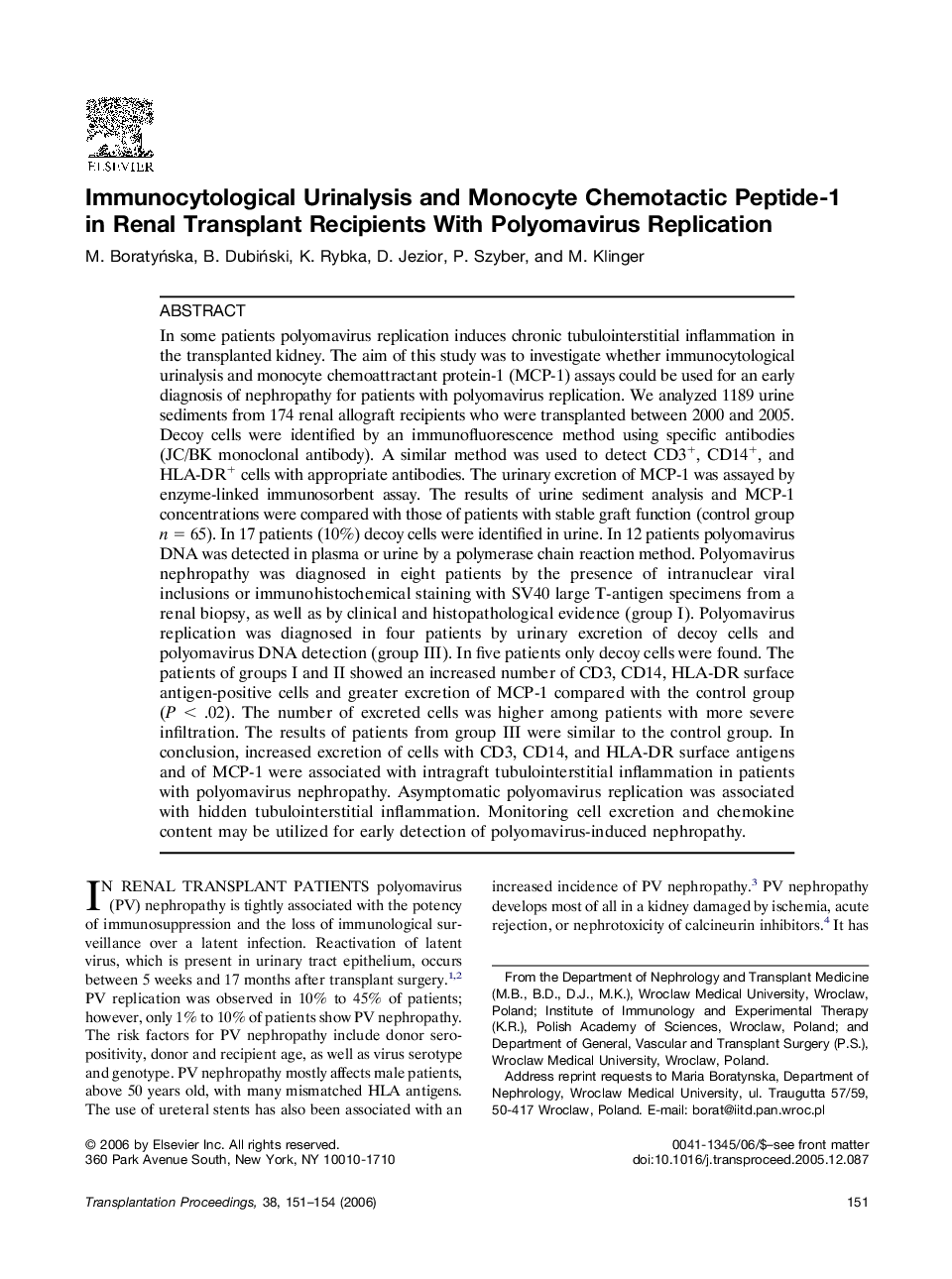| کد مقاله | کد نشریه | سال انتشار | مقاله انگلیسی | نسخه تمام متن |
|---|---|---|---|---|
| 4261804 | 1284599 | 2006 | 4 صفحه PDF | دانلود رایگان |
عنوان انگلیسی مقاله ISI
Immunocytological Urinalysis and Monocyte Chemotactic Peptide-1 in Renal Transplant Recipients With Polyomavirus Replication
دانلود مقاله + سفارش ترجمه
دانلود مقاله ISI انگلیسی
رایگان برای ایرانیان
موضوعات مرتبط
علوم پزشکی و سلامت
پزشکی و دندانپزشکی
عمل جراحی
پیش نمایش صفحه اول مقاله

چکیده انگلیسی
In some patients polyomavirus replication induces chronic tubulointerstitial inflammation in the transplanted kidney. The aim of this study was to investigate whether immunocytological urinalysis and monocyte chemoattractant protein-1 (MCP-1) assays could be used for an early diagnosis of nephropathy for patients with polyomavirus replication. We analyzed 1189 urine sediments from 174 renal allograft recipients who were transplanted between 2000 and 2005. Decoy cells were identified by an immunofluorescence method using specific antibodies (JC/BK monoclonal antibody). A similar method was used to detect CD3+, CD14+, and HLA-DR+ cells with appropriate antibodies. The urinary excretion of MCP-1 was assayed by enzyme-linked immunosorbent assay. The results of urine sediment analysis and MCP-1 concentrations were compared with those of patients with stable graft function (control group n = 65). In 17 patients (10%) decoy cells were identified in urine. In 12 patients polyomavirus DNA was detected in plasma or urine by a polymerase chain reaction method. Polyomavirus nephropathy was diagnosed in eight patients by the presence of intranuclear viral inclusions or immunohistochemical staining with SV40 large T-antigen specimens from a renal biopsy, as well as by clinical and histopathological evidence (group I). Polyomavirus replication was diagnosed in four patients by urinary excretion of decoy cells and polyomavirus DNA detection (group III). In five patients only decoy cells were found. The patients of groups I and II showed an increased number of CD3, CD14, HLA-DR surface antigen-positive cells and greater excretion of MCP-1 compared with the control group (P < .02). The number of excreted cells was higher among patients with more severe infiltration. The results of patients from group III were similar to the control group. In conclusion, increased excretion of cells with CD3, CD14, and HLA-DR surface antigens and of MCP-1 were associated with intragraft tubulointerstitial inflammation in patients with polyomavirus nephropathy. Asymptomatic polyomavirus replication was associated with hidden tubulointerstitial inflammation. Monitoring cell excretion and chemokine content may be utilized for early detection of polyomavirus-induced nephropathy.
ناشر
Database: Elsevier - ScienceDirect (ساینس دایرکت)
Journal: Transplantation Proceedings - Volume 38, Issue 1, JanuaryâFebruary 2006, Pages 151-154
Journal: Transplantation Proceedings - Volume 38, Issue 1, JanuaryâFebruary 2006, Pages 151-154
نویسندگان
M. BoratyÅska, B. DubiÅski, K. Rybka, D. Jezior, P. Szyber, M. Klinger,